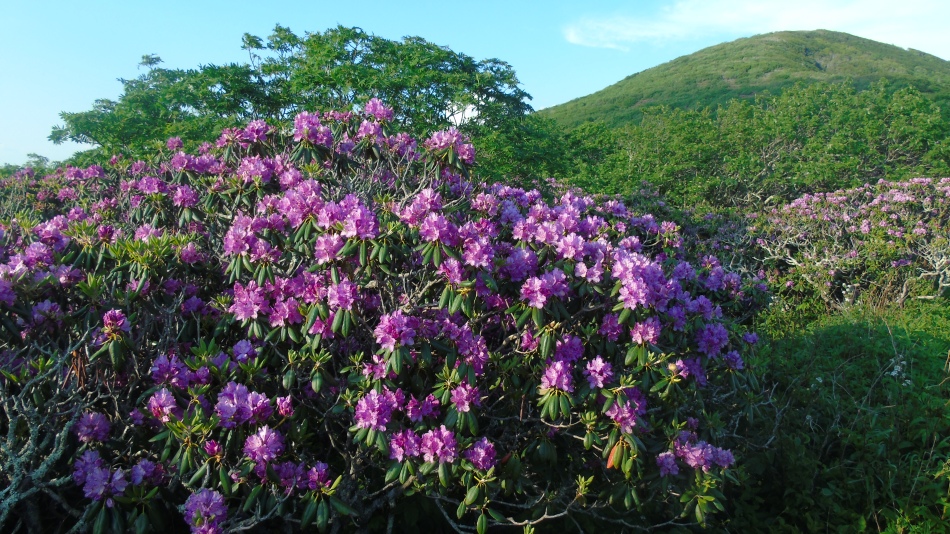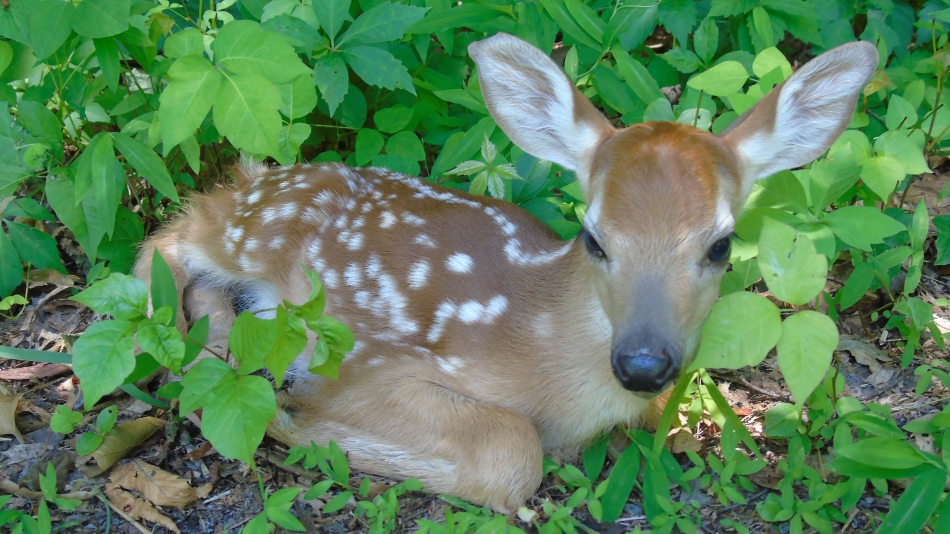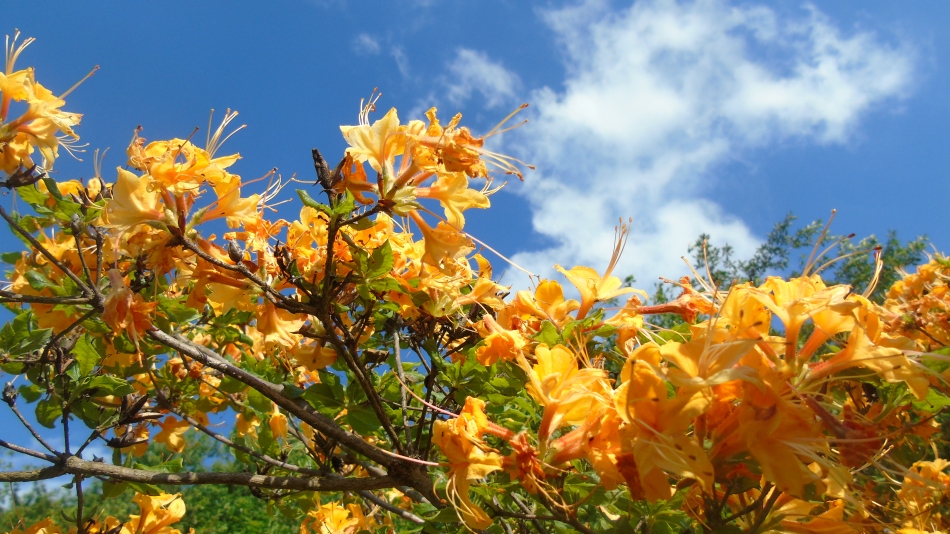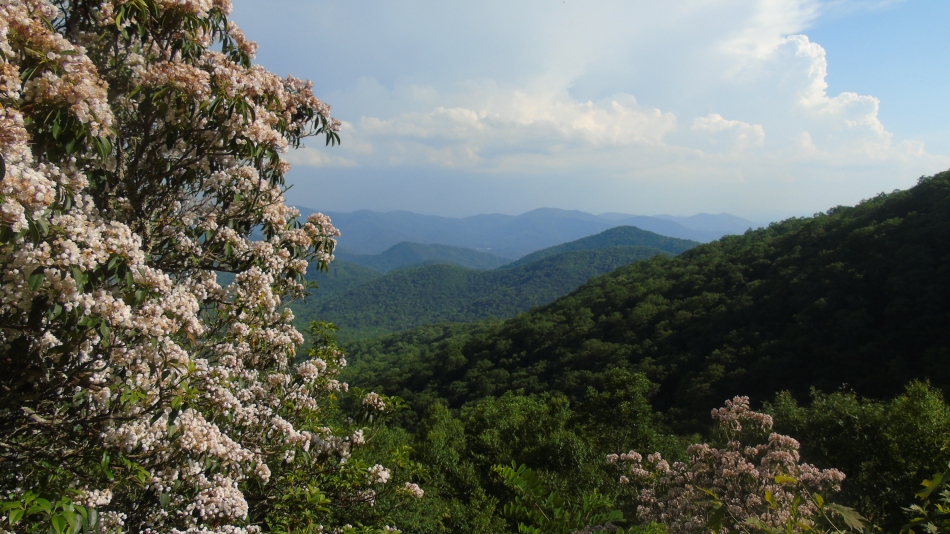Our Flowering Highlands
Variations of this post were published in June, 2016 in the Yancey Journal and Common Times, and
in the Asheville, Hendersonville, and Weaverville Tribune newspapers –Quilla
*
*
*

*
From my nature journal: “Steep and massive slopes cloaked with purple heather fall sharply into deep lowland glens rushing with rocky streams. This wild scenery, these primitive landscapes are the very essence of a mystic beauty that Celtic music brings to us with yearning pipes and flute, thumping bodhran, swirling kilt and fiddle. Voices keen and wail into the highland mists, longing for all things dear and lost in the ravages of war and time.”
—These are lines from several years ago, as we explored northern Scotland, so reminiscent of the remote high country of western North Carolina. Many native mountain-folk descend from the highlands of Scotland and Ireland, fierce bloodland of our hearty forefathers. Thus our colorful patchwork culture is still woven with ancient Celtic threads. Southern Appalachian music is rich with strains born centuries ago in the British Isles.
I recall herds of red deer, thick mists, rowan trees and purple heather shrouding the high shoulders of lofty Lochnagar, a high peak I climbed just south of Balmoral Castle. The raw beauty of that rugged land continues to haunt me with an elusive but certain longing. A bagpipe’s wild droning captures and renders it well.
Saturday, June 11: Today I satisfy that yearning and escape the intense lowland heat with a hike up into the cool breezy uplands. The Blue Ridge Parkway takes me to a little-known trail meandering across highland wild-grass meadows glowing bright purple with Catawba rhododendrons. The native flame azalea is also at its peak at this elevation, displaying a broad palette from pale yellow to deep scarlet. Complementing both of these winter-hearty shrubs are hundreds of mountain laurel, dazzling with clusters of white and pink blossoms. I find myself deep in a natural garden of mountain flowers, resplendent with colors under the vast blue sky.
I appreciate Wallace Stegner’s statement that “national parks are our nation’s one best idea”. Winding across the crest of four hundred miles of southern Appalachians, the Parkway is the most visited national park. It represents an escape, but also an entry—back into a world more beautiful, wild and coherent than the frenetic artificial world we’ve created in the noisy valleys below. We must ask: this highland beauty of sky and clouds, flowers and mountains—why does it keep drawing millions of visitors every year? Something deep in us longs to return–to wilder scenery and simpler ways.
The rewards of walking the high country are many, and varied. Today my path crosses that of a tiny fawn, less than a week old. I take a few pictures and walk on. Her mother is likely waiting nearby.
The shy winter Junco has returned to the high country to spin her nest of speckled eggs under a tussock of windy grass in the trail. Nearby, her mate trills his high single note of song, ringing like a wee glass bell from the branch of a blossoming rhododendron. The desire for Scotland subsides…
*

*
*
*

*
*

*
*
–Quilla
4 a.m., May 3…….
Looking up from reading Wolf Willow
…the clock quietly ticking…
suddenly I’m not alone in the cool
lamplit room:
Stegner is sitting there in the squeaking rocker,
rocking slowly, by the cold wood stove.
He says nothing, just a wry smile,
a knowing look, deeper
than his starry Manitoba sky.
Facing each other in old worn chairs,
Beston and Borland muse about New England,
blue blizzards and lilacs, blowing
endless seasons across the ancient glacial hills;
how gold sunlight shimmers the steep sand,
the white sea birds, cold blue waters
sparkling, forever breaking, shaping
the outermost Cape.
At the black window, holding a red and silver
balalaika, Pasternak stands vigilant
in an embroidered peasant shirt, looking out
into tall bare birches, cold spring stars.
He turns to me with that perennial question
on his raw-boned Russian face, revealing
the deep pathos of shattered ideals,
of war, and loss.
Suddenly Akhmatova blows in from the night,
chilled, scented with passion and dried perfume,
broken loves like tender blossoms,
drops of blood on late spring snow ….
And over in the shadows sits
dark-eyed Jane Kenyon: her fingers resting
from gardening, from making luminescent words.
She puts down her half-empty glass of red wine
and crumbles old newspapers with split kindling.
Her voice is rich with flowers, and the sorrow
of killing frost, saying to the rest of us
“someone needs to build a fire”.
*
*
–Quilla
